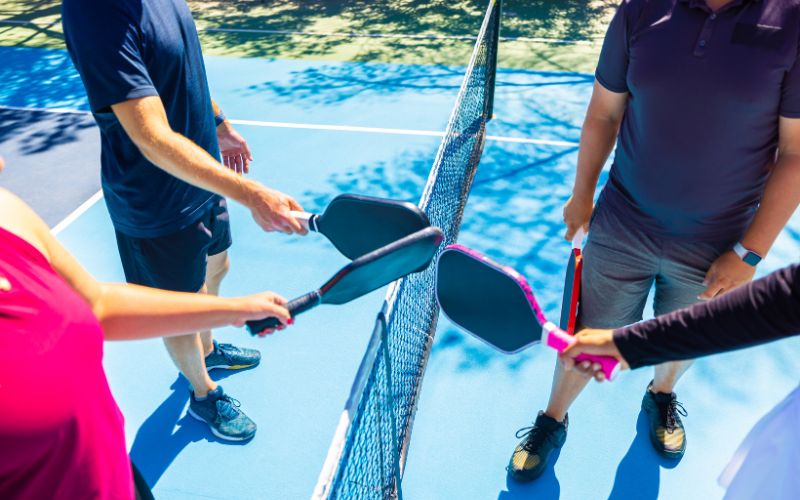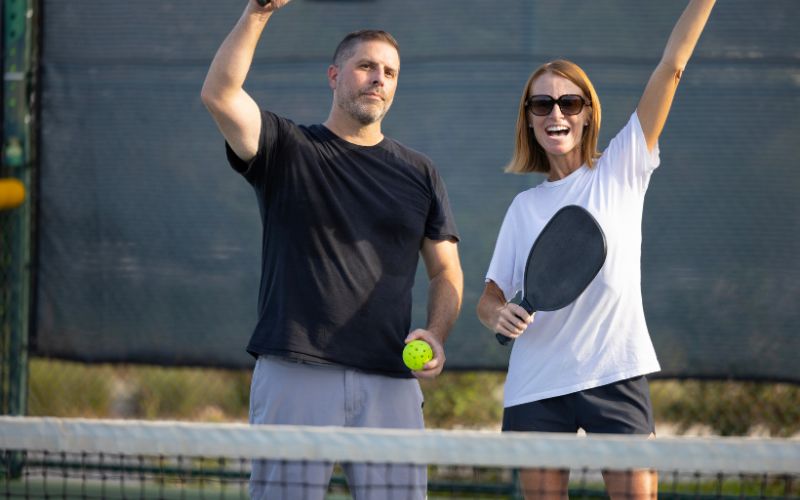Pickleball, a sport that combines elements of tennis, badminton, and table tennis, has rapidly gained popularity across the globe. Central to the game is the paddle, and how you grip it can significantly influence your performance. This article will guide you with Pickleball Grips Variation to the nuanced techniques used by professionals, enhancing your understanding and skill in the game.
The Importance of the Right Pickleball Paddle Grips
The way you hold your paddle is fundamental to your ability to hit the ball accurately and with power. A proper pickleball paddle grip can improve your shot precision, reduce the risk of injury, and give you a variety of shot options.
The Basic Grip: Shake Hands with Your Paddle
The most common and fundamental grip in pickleball is the Continental Grip. It’s often described as shaking hands with your paddle, where the paddle handle lies against your palm.
Continental Pickleball Grip
The Continental grip, often referred to as the “hammer grip,” is one of the fundamental grips in pickleball and is used for a variety of shots, from serves to volleys and drives. It is named for its prevalence among European players, who were among the first to adopt it in tennis, and it has since become a staple grip in pickleball as well.
How to Achieve the Continental Pickleball Grip:
- Extend your hand as if you are going to shake hands with someone.
- Place the paddle handle so that the V formed by your thumb and index finger is aligned with the edge of the paddle.
- Wrap your fingers around the handle, keeping a firm yet relaxed pressure.
The Eastern Pickleball Grip: Transitioning to More Control
As players become more comfortable with the basics, they often transition to the Eastern Grip. This grip allows for more wrist action, which can generate topspin and better control over the ball.
How to Achieve the Eastern Grip:
- Rotate your hand slightly so that the palm is more on top of the handle.
- The V formed by your thumb and index finger should now be slightly to the right side (for right-handed players) of the paddle’s edge.
- The knuckle of your index finger should be aligned with the top of the paddle handle.
Positioning Your Hand
Imagine you are about to hammer a nail or shake someone’s hand. This is the natural position for the Continental grip.
The base knuckle of your index finger and the heel of your hand will be on the same bevel of the paddle handle. For a pickleball paddle, which typically has a rectangular handle, this would be the top-left bevel for right-handed players and the top-right bevel for left-handed players.
Advantages of the Continental Grip
- Versatility: It allows players to easily switch between forehand and backhand shots without changing grips.
- Simplicity: It is a simple grip that can be used for almost every shot in pickleball, making it ideal for beginners.
- Serve and Volley: It is particularly effective for serving and volleying because it naturally aligns the paddle face for a flat shot.
Using the Grip in Play
- When holding the paddle with a Continental grip, the paddle face is perpendicular to the ground, which is suitable for hitting flat shots with minimal spin.
- It provides a stable wrist position, which is beneficial for hitting powerful serves and smashes.
- The grip also allows for quick transitions to defensive shots, such as blocks and dinks, without the need to adjust your hand position.
- The grip pressure should be firm enough to control the paddle but relaxed enough to allow for wrist flexibility. A death grip on the handle can lead to arm fatigue and a lack of finesse in shots.
Considerations
While the continental grip offers many advantages, it may not be as conducive for shots that require heavy topspin or extreme angles, which other grips, like the Eastern or Western, may better facilitate.
Players might find it challenging initially to generate spin with this grip, but with practice, it can be used effectively for a wide range of shots.
The Western Pickleball Grip: For Advanced Top Spin
The Western grip in pickleball is a more advanced grip technique that is particularly used to generate a significant amount of topspin on the ball. This grip is less common than the Continental or Eastern grips and is often used by players who have a strong preference for forehand shots and are looking to add an aggressive spin to their play.
The Western Grip is less common but can be effective for advanced players who want to put a significant amount of topspin on the ball.
How to Achieve the Western Grip:
- Rotate your hand further so that the palm is under the handle when hitting forehand shots.
- The V should now be on the bottom right side (for right-handed players) of the paddle’s edge.
- This grip can make it challenging to hit backhand shots, so it’s typically used by players with a strong forehand preference.
Positioning Your Hand
To achieve the Western grip, you place your hand so that the palm is underneath the paddle handle during the forehand stroke.
The base knuckle of your index finger is placed under the paddle handle, which is a more extreme position compared to the Continental or Eastern grips.
Advantages of the Western Grip
- Topspin: The Western grip naturally angles the paddle face upwards, which makes it easier to brush up behind the ball, generating topspin.
- Aggressive Shots: The topspin created with this grip allows the ball to dip quickly over the net, making it a powerful tool for aggressive play.
- High Bounces: Topspin shots tend to bounce higher, which can be challenging for opponents to return, especially if they are not at the optimal distance from the net.
Using the Grip in Play
- When pickleball players use the Western grip, players typically swing from low to high, brushing up the back of the ball to impart the topspin.
- It’s particularly effective when you have time to set up for a forehand shot and can predict the ball’s trajectory.
- Similar to other grips, maintaining a balanced grip pressure is important. Too tight, and you may lose the flexibility needed to create spin; too loose, and you may not have sufficient control over the paddle.
Considerations
Backhand Difficulty: The Western grip can make backhand shots more challenging because of the extreme angle of the paddle face. Players often have to switch grips or adjust their hand position significantly to execute a backhand effectively.
Precision: While the Western grip is excellent for generating spin, it can be less precise than other grips. It requires a good deal of practice to maintain control over shot placement.
Transition Time: Switching between the Western grip and other grips can take time, which might not be ideal in a fast-paced pickleball game where quick reactions are necessary.
Understanding Grip Pressure
Grip pressure is crucial. Squeezing the paddle too tightly can lead to arm fatigue and a loss of control, while too loose a grip can cause the paddle to slip, especially if you have sweaty hands.
Advanced Techniques and Variations
As players progress, they often develop their own variations of these grips to suit their playing style. For instance, some may adjust the angle of the paddle face slightly to enhance their swing or control the direction of the ball more precisely.
1. The Hammer Grip for Power Shots
Some advanced players use a grip known as the Hammer Grip for power shots. This grip involves holding the paddle as if you were holding a hammer, with a focus on using the wrist to generate power.
2. The Ping Pong Grip for Quick Reflexes
Players coming from table tennis backgrounds may use a grip similar to the Ping Pong Grip, which allows for quick wrist movements and fast reflexes.
3. Customizing Your Grip for Different Shots
- Forehand Shots: A slightly looser grip can provide more flexibility and spin.
- Backhand Shots: A firmer grip can offer more stability and power.
- Serving: A medium grip pressure is typically used to balance power and control.
4. Adjusting for Paddle Weight and Handle Thickness
The weight of your paddle and the thickness of the handle can also affect how you grip it. Players with smaller hands may prefer a thinner handle for a more comfortable grip, while those with larger hands may opt for a thicker handle for better grip strength.
To further enhance your understanding, here are some video resources that demonstrate various grip techniques:
- “The Best Pickleball Grip” – https://www.youtube.com/watch?v=I8oN9TiQMG0
Replacement Grips and Overgrips
Over time, the grip on your paddle can wear down, or you may just want to customize the feel of your grip. Replacement grips and overgrips are available to address these needs.
Choosing the Right Replacement Grip:
- Thickness: Affects the overall size of the handle.
- Texture: Influences the grip’s feel and the amount of slip resistance.
- Material: Impacts the grip’s durability and absorption of sweat.
Understanding and mastering the various pickleball grip variations can significantly elevate your game from basic to pro. Remember to practice each grip and find what works best for your style of play. With the right grip, you’ll have more control, power, and versatility on the pickleball courts.
Frequently Asked Questions
How often should I replace my pickleball grip?
It depends on how frequently you play and your personal preference for grip texture and tackiness. A general rule of thumb is to replace your grip when it starts to feel worn or loses its tackiness.
Can I use tennis overgrips for my pickleball paddle?
Yes, tennis overgrips can be used on pickleball paddles and are often preferred by players for their variety and availability.
Does grip size affect my game?






